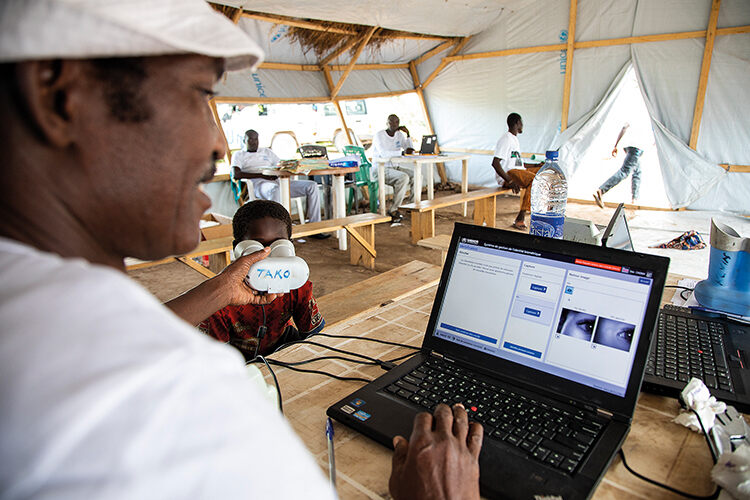
A reliance on biometric data in the humanitarian sector is on the rise, despite growing evidence of the risks
In 2021, as US troops withdrew from Afghanistan – the culmination of two decades of war – they left behind a vast collection of sensitive data that swiftly made its way into the hands of the Taliban. According to the NGO Human Rights Watch, this included biometric data such as iris scans and fingerprints, as well as photographs, addresses and names of relatives, possibly endangering thousands of Afghans around the country. ‘Some of these people would have assisted or worked at US embassies and were likely made promises of resettlement opportunities in the USA,’ says Quito Tsui, one of the authors of a new report on the problem.
The practice of collecting biometric data from vulnerable individuals isn’t unique to Afghanistan. The report, written by Tsui and her colleagues at the Engine Room, a non-profit organisation with expertise in technology and data, details several high-profile incidents of the growing use – and risks – of biometrics in the humanitarian sector.
According to the UN, an estimated 360 million people worldwide are currently in need of humanitarian assistance, an increase of 30 per cent since the start of 2022. Humanitarian organisations are finding it increasingly challenging to meet those needs, and biometrics were first adopted during the early 2000s as a way of facilitating aid registration and distribution (many people in need of aid don’t possess identification documents such as a passport).
Since then, the use of digital biometric systems to collect data such as iris, hand or fingerprint scans has become normalised and a central part of humanitarian work. Some organisations have also been encouraged by donors that request detailed reports on how their money has been spent. By the end of 2020, almost 63.8 million biometric profiles were registered with the World Food Programme’s SCOPE database.

However, Tsui explains that while aid organisations cite the numerous benefits of using biometric data systems – such as increased efficiency and fraud control – there’s little in the way of evidence or research to actually support these claims. Most importantly, says Tsui, many organisations have failed to review their use of biometric data in light of the increased evidence of harm it can cause.
The main issues raised by the new report include function creep, data security and the misuse of data. ‘In most situations, the risks that individuals who depend upon humanitarian aid face when their data is collected are the same risks that you or I might face,’ says Tsui. ‘The key difference is that these risks are much more likely to occur.’ In 2018, Open Democracy reported that Rohingya refugees at a camp in Bangladesh protested against the issue of smart ID cards after the Bangladeshi government shared biometric data with the Myanmar junta, which has persecuted the Rohingya people.
Tsui says that of all the issues associated with biometric data collection, lack of consent is particularly tricky. ‘People fleeing harm often arrive in huge groups, in a rush, maybe even in the middle of the night,’ she says. ‘That’s not an environment that’s conducive to informed consent.’ More often than not, the reality is that individuals seeking aid are in no position to refuse. ‘When we’ve asked aid organisations about what happens if people do say no, they’ve been evasive,’ says Tsui. ‘In reality, there often is no alternative in place.’
It may seem as if it’s too late to turn back from the reliance on biometrics, but Belkis Wille, associate director with the Crisis and Conflict division at Human Rights Watch, says that the humanitarian response to the war in Ukraine suggests otherwise. Many Ukrainians and the smaller, local humanitarian groups supporting them didn’t want to share their biometric data with international agencies and, as a result, those agencies dropped the requirement. ‘Ukraine has certainly made the argument in favour of biometric data collection harder to justify,’ agrees Tsui.




